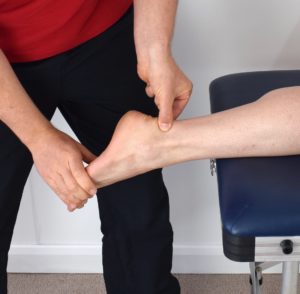 Aloha all! I sought out Graston Technique® training after my Chiropractors (Dr. Paul Thurlow and Dr. Kyle Moser) helped me get rid of Plantar Fasciitis pain in just 6 treatments — and oh yes, I also use it on the Achilles tendon (see photo at left as to where it is). I am so in love with this therapy and use it as much as possible with clients. Often times, they have hand and foot pain. I’m excited to be working with more Runners!
Aloha all! I sought out Graston Technique® training after my Chiropractors (Dr. Paul Thurlow and Dr. Kyle Moser) helped me get rid of Plantar Fasciitis pain in just 6 treatments — and oh yes, I also use it on the Achilles tendon (see photo at left as to where it is). I am so in love with this therapy and use it as much as possible with clients. Often times, they have hand and foot pain. I’m excited to be working with more Runners!
Graston Technique® is particularly useful for tendon issues and is gaining increasing presence in sports medicine, athletic training programs, and physical therapy. To be clear — if you have a serious case of tendinopathy, with degeneration, or a tear, you would be best served with a medical diagnosis, and a presciption for physical therapy. If you live in Hawaii, I can provide referrals to wonderfully qualified PTs who can include Graston Technique® in the care plan. If you have more of a nagging chronic pain that doesn’t allow you to enjoy your physical activities to the fullest, we can schedule a consultation.
What I like to do with friends and clients is to combine Pilates and Dynamic Conditioning with a little bit of hands-on therapy such as Graston Technique® — which I can do as a Certified Graston Technique® Specialist, a Licensed Massage Therapist, a Level 3 Certified Franklin Method® Movement Educator, and Certified Pilates Teacher — I have worked alongside some amazing Physical Therapists in Honolulu and Kailua (Oahu), Hawaii since 2011. For sure, I am not your typical “Pilates” teacher.
Pilates is also a fantastic way of retraining your muscles, tendons, and other connective tissue because it involves something called Eccentric muscle contractions. I learned from one of my movement teachers, the amazing Eric Franklin, that eccentric work (Dynamic conditioning) is the fastest way of making your muscles both strong and flexible — which then helps to protect your joints, and make your body feel better with whatever you are doing. I have loads of Franklin Method® Dynamic exercises for you to try as well!
What is Eccentric exercise — and how does it help with tendon issues? It involves a slow contraction of muscle with some resistance against your effort. It is something that is sorely lacking in a lot of gym workouts, which focus on a lot of pushing and pulling, then letting go. Which unfortunately, is apt to lead to an injury, as well as tight muscles, and less range of motion. It is also possible to focus on way too much stretching, and not enough resistance/stabilization, in the fitness world. This is more likely to happen to people have trained in Dance or Gymnastics for years — they’ll talk about how their teachers bent them into insane stretches and pushed down on them. Word to the wise: if you are in a Yoga class, do not allow your teacher to force you into a stretch; and also please be mindful if you are naturally hyper-mobile. Because it is entirely possible for hyper-mobility to haunt you later in life, like with a painful spine condition called spondylolisthesis.
You will often experience Eccentric type of work with a Physical Therapist, with very light resistance. There are also advanced techniques used by licensed massage therapists and others in the health and wellness field, called PNF stretching, which involves eccentric contractions. I learned some great techniques through Robert Haase and cannot wait for his next workshop in Hawaii (March 2019 by the way).
Please feel free to shoot me some questions by email! And I’d love to also see you for an in-person consultation: www.lahelafit.com.
With Aloha,
Lahela
Certified Graston Technique® Specialist
Board Certified, Licensed Massage Therapist (MAT#6286, NCBTMB# 307766-00)
Pilates Method Alliance and STOTT PILATES® Certified Pilates Teacher
Franklin Method® Level 3 Certified Movement Educator



Informative and helpful, learn a new things today. Thanks for sharing.
Thank you so much, I am honored.
Great article, nice content, good read and informative.
Thank you, Joefine.